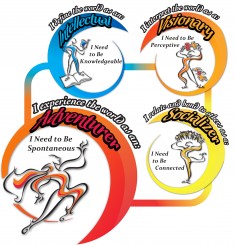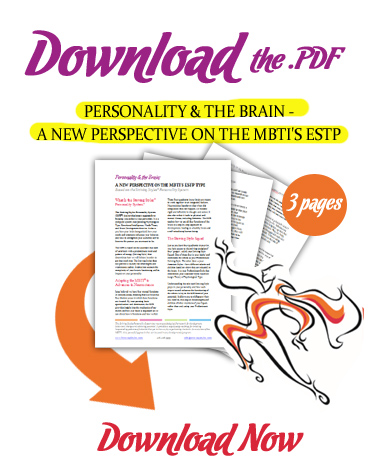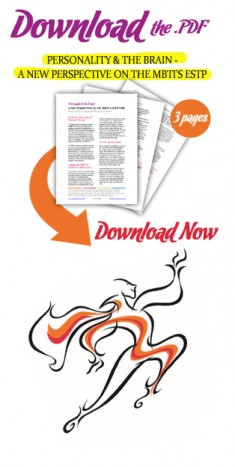Personality & the Brain - A New Perspective on the MBTI's ESTP
Personality & the Brain - A New Perspective on the MBTI's ESTP
Through the lens of the Striving Styles, each of the Myers-Briggs (MBTI®) 16 Types comes alive. Discover which quadrant of the brain the ESTP prefers to use, what the predominant, innate psychological need that drives the ESTP's behavior is, as well as how an ESTP can leverage their whole brain in order to develop and achieve their potential.
Four Quadrant Model of the Brain
The SSPS shows that each of the four quadrants of the brain has their own role, or function, to play in our personality and our consciousness. Based on Jung's Theory of Psychological Type, we are hard-wired to prefer one function or quadrant over the others and we use each quadrant or function in either an inwardly or an outwardly way.
The ESTP's Predominant Striving Style is the Adventurer, which is rooted in the left emotional brain (Jung's Sensing function) and focused externally. This is the part of the brain responsible for experiencing physical sensations. The most mechanistic of the four quadrants, it repeats activities in an impersonal and automatic manner in order to produce desired sensations. Present-oriented, this part of the brain sequences activities and follows the set course of action to achieve the desired experience. As its goal is to produce sensations, it is quick to figure out how an object, situation or person might create the type of sensations it wants to feel.
If the left emotional brain could talk, it would say things like, "Just tell me what I need to do and I'll do it. I'm not really interested in why I need to do it that way, just let me get to it. The left emotional brain doesn't reflect on the "why" of things, only on the "how". It completes tasks without the need to understand the big picture.
Drivers of Human Behavior: Needs & Emotions
Each of us is driven by powerful, instinctual needs and have been since birth. These needs are a source of motivation and influence our behavior. When our predominant need is met, we are poised for growth. When our need is not met, fear and anxiety override rational, leading to self-protective or survival behaviors.
ESTPs, as Adventurer Style people, have a predominant need to be spontaneous. These energetic, action-oriented people make things happen. With a talent for making even the most mundane events seem exciting, they live for the enjoyment of the moment. Tolerant, unprejudiced, and open to new experiences, they seek the freedom to approach each new day as if it is an adventure.
When their need to be spontaneous is frustrated, the Self-Protective System of the Adventurer (ESTP) is activated, causing survival behaviors to emerge including:
- refuse to plan and make commitments they don't intend on keeping
- avoid difficult situations; don’t tolerate interpersonal conflict or tension
- are impulsive and act without thinking of the consequences
- take excessive risks without concern for themselves or others
Using the Whole Brain: Striving Style Squad
Going beyond the descriptors of the MBTI, the SSPS shows people how to access and integrate all four quadrants of their brain in order to use their whole brain as it is intended. There are four Styles that make up a person's Striving Style Squad, each with its own role to play in our personality based on where they reside in the brain.
The Striving Style Squad for the ESTP is: Adventurer Predominant Style with Intellectual, Visionary & Socializer Associate Styles. Each Associate Style on the Squad also has a specific need that must be met and different innate talents that allow it to meet that need. Often, we neglect the development of the Associate Styles, resulting in the overuse of our Predominant Style which is a detriment to our confidence and mental health.
If we are not using the appropriate quadrant of our brain and its associated Style for its intended purpose, we end up using a different part of our brain in a way that it was not intended to be used. This can limit our flexibility, drain us of valuable internal resources, and ultimately thwart our development and growth in life.
Want to know more about the Striving Style Squad of the ESTP? Download our PDF now! To learn about the other MBTI Types, click here.

Adventurer Left Striving Style Squad: Adventurer Predominant with Intellectual, Visionary and Socializer Associates. Learn how to develop the whole brain of an ESTP with our Leveraging Your Squad Report.

Join us for one of our upcoming webinars. We offer a variety of webinars on other topics to help you take the MBTI to the next level! LEARN MORE...








